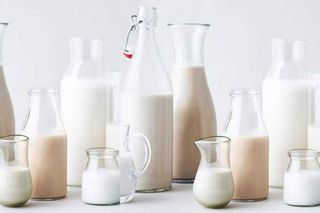
Does the Ideal Healthy and Environment‑Friendly Plant Milk Exist? Not Really.
While oat milk and soy milk get close, most plant milks still need loads of processing to be nutritionally viable.

Perhaps you’re a wellness enthusiast. Perhaps you’re lactose intolerant. Perhaps you care about the environment. Or perhaps, you’ve come across some particularly unfortunate cow-pus content. Either way, milk made from water-based plant extracts is proving to be an important replacement for cow’s milk — especially considering the environmental ramifications of the dairy industry and the potential side-effects of frequent tall glasses of milk.
A variety of plant milks have emerged to meet the demand for a milk-substitute — like oat milk, almond milk, soy milk, rice milk, coconut milk, flax milk, hazelnut milk — even peanut milk. While plant milk is definitely made with less cruelty and environmental strain, it is also not as nutritious as cow’s milk and comes with relatively more added sugars and artificial ingredients. In order to not lose out on a potent source of nutrition, it helps to find types of plant milk that can closely match the protein, vitamins, minerals, sugars, and fats found in cow’s milk.
We tried to figure out which commonly available plant milk is both environmentally less damaging and healthy enough to provide a nutrient profile somewhat similar to cow’s milk. However, plant milk is not the most ideal replacement for animal milk — their production still uses up an enormous amount of energy and water, though significantly lesser as compared to the dairy industry.
Coconut Milk
Often a staple ingredient in Thai and South Indian curries, coconut milk is made from the nut’s white flesh. It has rich, almost-overpowering sweet and creamy flavor. Coconut milk is chock-full of medium-chain triglycerides, potassium, magnesium, and calcium — which are good for weight loss, cardiovascular health, bone health, fighting diabetes, among its other benefits. However, coconut milk contains very little protein and a significant amount of fat, which must be accounted for if incorporated into one’s diet.
Coconut milk has one of the more eco-friendly production processes — an adult coconut tree (palm) in India requires around 600-700 liters of water every week, which may sound like a lot when it’s a stand-alone number, but sounds like nothing in comparison to the 2000 gallons (around 7,571 liters) of water required to create one gallon (around 4 liters) of cow milk.
Almond Milk
Almond milk is also a nut-based plant milk that has a creamy, nutty taste. While highly popular, the only real benefit of raw almond milk is that it is low-fat. Since almond milk is made from skinless almonds, the nut is robbed of its anti-oxidants; the milk presents only a watered-down version of the almond’s nutrients. Almond milk is also not a good source of protein or fats. It’s better to consume it when enriched with vitamins and minerals during the production process.
To make a glass of almond milk, one would require about 74 liters of water. Almond milk is also hard on the environment — each almond takes a gallon (five liters) of water to produce, which is extremely hard on drought-struck regions like California in the U.S, which produces 80% of the world’s almonds. Almond farming is also endangering honeybees, due to the insecticides used for the crop, poisoning bees to death in large numbers while they pollinate almond trees.
Related on The Swaddle:
Untrending: If You’re Already Healthy, You Don’t Need Kombucha or Kefir
Soy Milk
Soy milk is made by soaking, grinding soybeans first and then boiling, filtering out the milk. This legume-based plant milk does not taste sweet but has a creamy consistency. Soy milk contains the highest amount of protein amongst the different plant milks in the list. It is a source of calcium, protein, isoflavones, monounsaturated and polyunsaturated fatty acids. It is also free from cholesterol and lactose (sugar). This makes it excellent for cardiovascular health, bone health and provides a protective effect against cancer.
While the production of soy in general causes much environmental strain — soy is amongst the four items (the other three being beef, palm oil, and wood) driving most of the tropical deforestation. However, a very small percentage of the soy grown goes into the creation of soy milk — the rest of the soy goes into creating animal feed for the meat and dairy industry. Around 297 liters of water are used to produce a liter of soy milk, which is extremely low compared to other plant milk sources.
Rice Milk
Rice milk is also a cereal-based milk made via a blending and straining process. Its taste and texture are similar to cow’s milk and its popular with those allergic to milk and dairy, because it is the least likely kind of plant milk to cause allergies. Rice milk is high in carbohydrates, but not a natural source of nutrients though it can be fortified with them. It also contains very little proteins and no fat.
Rice milk requires 54 liters of water to create one glass, which is still a significant amount, but smaller than that required to make almond milk and cow’s milk.
Oat Milk
Oat milk is made by blending water and oats, then straining out the milk. This cereal-based plant milk also loses its nutrition due to dilution with water but can be enriched with various vitamins and minerals. Oat milk also comes with beta-glucans, which are a soluble dietary fiber that improves cardiovascular health. Oat milk also doesn’t have a significant amount of protein or fat.
As for its environmental impact, oats are rain-fed crops grown in the winter, with the occasional supplemental irrigation. One liter of oat milk requires 48 liters of water to produce, which means they do not need as much water as any of the other plant milk options.
For everyday use and as a substitute to cow’s milk, oat milk remains the most sustainable option, while soya milk remains the healthiest option. Fortified oat milk could help overcome raw oat milk’s vitamin and mineral deficiency, but one must keep in mind that processed plant milk will come with added sugars and artificial ingredients, and that one must remember to add more proteins to their diet in order to keep it balanced.
Aditi Murti is a culture writer at The Swaddle. Previously, she worked as a freelance journalist focused on gender and cities. Find her on social media @aditimurti.
Related


Gender‑Affirming Surgery Improves Mental Health for Transgender Folk, Study Confirms
